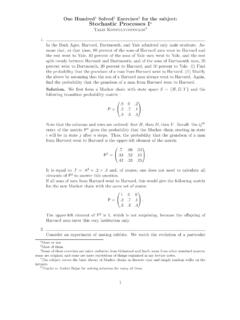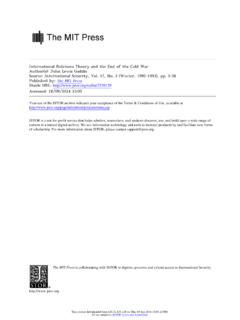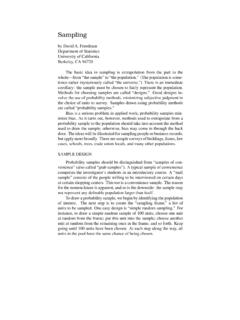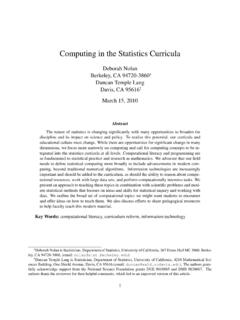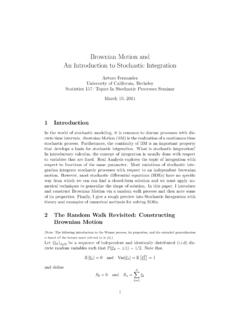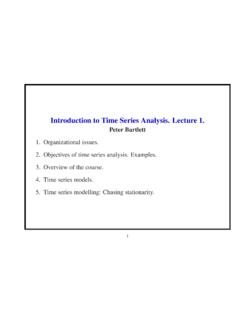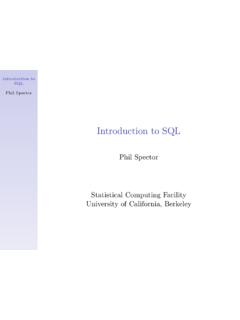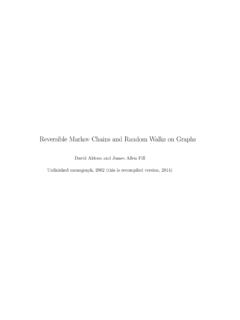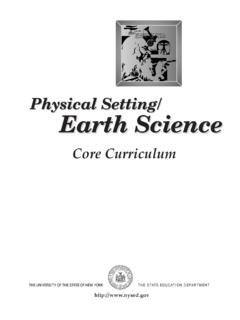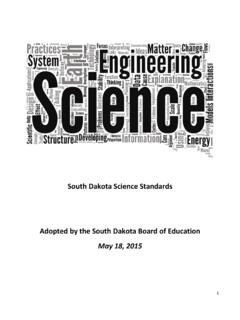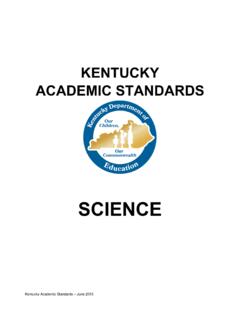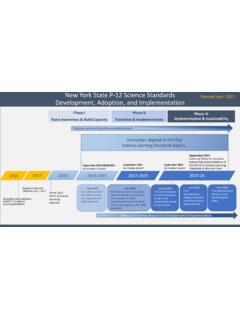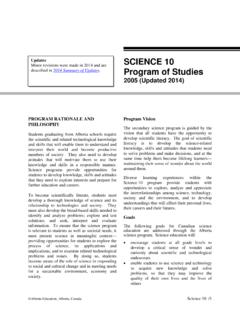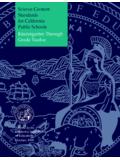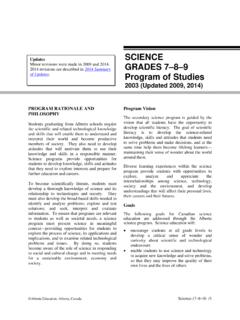Transcription of Curriculum Guidelines for Undergraduate Programs in …
1 Curriculum Guidelines forUndergraduate Programsin Data SciencePark City Math Institute (PCMI) Undergraduate Faculty GroupRichard De Veaux (chair), Mahesh Agarwal, Maia Averett, Benjamin Baumer,Andrew Bray, Thomas Bressoud, Lance Bryant, Lei Cheng, Amanda Francis,Robert Gould, Albert Y. Kim, Matt Kretchmar, Qin Lu, Ann Moskol, DeborahNolan, Roberto Pelayo, Sean Raleigh, Ricky J. Sethi, Mutiara Sondjaja, NeeleshTiruviluamala, Paul Uhlig, Talitha Washington, Curtis Wesley, David White,Ping YeAnnual Review of Statistics :1 26 This article s ((please add article doi))Copyrightc 2016 by Annual rights reservedKeywordscurriculum, statistics education , computer science educationAbstractThe Park City Math Institute (PCMI) 2016 Summer UndergraduateFaculty Program met for the purpose of composing Guidelines for un-dergraduate Programs in Data Science. The group consisted of 25 un-dergraduate faculty from a variety of institutions in the , primarilyfrom the discipines of mathematics, statistics and computer Guidelines are meant to provide some structure for institutionsplanning for or revising a major in Data Introduction.
2 22. Background and Guiding Data Science as Science .. Interdisciplinary Nature of Data Science .. Data at the Core .. Analytical (Computational and Statistical)Thinking .. Mathematical Flexibility .. 63. Key Competencies and Features of a Data Science Major .. Analytical (Computational and Statistical) Thinking .. Mathematical Model Building and Assessment .. Algorithms and Software Foundation .. Data Curation .. Knowledge Transference .. 94. Curricular Content for Data Science Majors .. Overview of Course 115. Additional Considerations .. 136. Transitioning to a Data Science Major Using Typical Existing Courses .. Courses in Courses in Computer Science .. Courses in Related Courses .. 157. Summary and Next Steps .. 168. Appendix Detailed Courses for a Proposed Data Science 171. IntroductionData Science is experiencing rapid and unplanned growth, spurred by the proliferation ofcomplex and rich data in science, industry and government.
3 Fueled in part by reports suchas the widely cited McKinsey report that forecast a need for hundreds of thousands ofData Science jobs in the next decade (McKinsey), Data Science Programs have explodedin academics as university administrators have rushed to meet the demand. The lists 530 Programs in Data Science, ana-lytics and related fields at over 200 universities around the world. The vast majority ofthese are master s degree and certificate Programs offered both traditionally and PhD Programs in Data Science (or Data Analytics) are still relatively rare, there hasbeen rapid growth of Undergraduate Programs at both research institutions and liberal artscolleges. We expect this number to increase significantly in the near 2016 Park City Mathematics Institute (PCMI), sponsored by the National ScienceFoundation (NSF) and the Institute for Advanced Study at Princeton (IAS), held a work-shop for Undergraduate faculty focused on the task of producing Curriculum Guidelines foran Undergraduate degree in Data Science.
4 Twenty-five faculty, comprised of computer sci-entists, statisticians and mathematicians from a variety of liberal arts colleges and researchuniversities, met for three weeks to discuss our vision for Data Science in an undergradu-2 Park City Math Institute (PCMI) Undergraduate Faculty context, what activities and skills we thought would be necessary for a Data Scienceprogram and how we could imagine implementing such a major both currently and in thefuture. These Guidelines are the product of that have based our Guidelines for an Undergraduate Data Science major on a tensemester-course major common among the liberal arts colleges, realizing that research uni-versities typically add several courses to that. We do not intend that these Guidelines beprescriptive, but rather we hope that they will serve to inform and enumerate the core skillsthat a Data Science major should have before graduation. We started with the reports fromthe NSF Workshop on Data Science education (See Strengthening Data Science Educationthrough Collaboration , October 1-3, 2015), the AALAC Big Data Conference (Wellesley,January 2016) and the Guidelines for Undergraduate majors in Mathematics, Statistics andComputer Science (see sidebar).
5 Curriculum Guidelines in Related Disciplines2015 CUPM Curriculum Guide to Majors in the Mathematical sciences (MAA) Science Curricula 2013: Curriculum Guidelines for Undergraduate Degree Pro-grams in Computer Science (ACM) Guidelines for Undergraduate Programs in Statistical Science (ASA) begin by discussing the background and some guiding principles that informed ourthinking in Section 2, then consider skills that students should develop while pursuing themajor in Section 3, and finally summarize key Curriculum topics in Sections 4 and 5. Weshow a possible selection of current courses that do cover most of the basics of our identifiedskills in Section 6. However, it is important to point out that this smorgasbord approachto course selection is less than ideal. We believe that many of the courses traditionallyfound in computer science, statistics and mathematics offerings should be redesigned forthe Data Science major for the sake of efficiency and of the potential synergy that integratedcourses would offer.
6 Relying on existing courses at most institutions, a student might haveto take 14 or more courses in order to obtain all the skills one would expect from a DataScience major. With some significant course redesign, we think that this number could besubstantially reduced to fit into the constraints of a typical 10-course liberal arts of those courses are found in the Background and Guiding PrinciplesOur Curriculum Guidelines are guided both by recent work on the relation of data scienceto the other sciences as well as the need for a workforce better able to meet the demandsof the data-driven economy of the Data Science Guidelines Data Science as ScienceEven though an exact definition of Data Science remains elusive, we have takenas our starting point a view that seems to have emerged as a consensus from theStatSNSF committee statement that Data Science comprises the science of plan-ning for, acquisition, management, analysis of, and inference from data.
7 At the undergrad-uate level, we conceive of Data Science as an applied field akin to engineering, with itsemphasis on data and how it describes the world. At present, the theoretical foundationsare drawn primarily from established strains in Statistics, Computer Science, and Mathe-matics. The practical real-world meanings come from interpreting the data in the contextof the domain in which the data arose. For an Undergraduate program, we envision acase-based focus and hands-on approach, as is common in fields such as engineering andcomputer Data Science a Science?There is still considerable debate about exactly what the science of Data Science is, but prominent scientistssuch as David Donoho, Michael Jordan and others suggest that there is a science at the core and that itwill continue to evolve. As Donoho says, Fortunately, there is a solid case for some entity called DataScience to be created, which would be a true science: facing essential questions of a lasting nature and usingscientifically rigorous techniques to attack those questions.
8 Regardless of the consensus (or lack thereof)surrounding the evolution of the science of Data Science, a Data Science program at the Undergraduate levelprovides a synergistic approach to problem solving, one that leverages the content in all three believe that a Data Science program will serve students well whether they join the marketplace orcontinue on to more advanced Interdisciplinary Nature of Data ScienceData science is inherently interdisciplinary. Working with data requires the mastery of avariety of skills and concepts, including many traditionally associated with the fields ofStatistics, Computer Science and Mathematics. Data Science blends much of the peda-gogical content from all three disciplines, but it is neither the simple intersection, nor thesuperset of the three. By applying the concepts needed from each discipline in the context ofdata, the Curriculum can be both significantly streamlined and enhanced. The integrationof courses, focussed on data, is a fundamental feature of an effective Data Science programand results in a synergistic approach to problem document outlines the core knowledge and methods that Data Science studentsshould master.
9 Our position is that, ideally, new courses should be developed to takeadvantage of the efficiencies and synergies that an integrated approach to Data Sciencewould provide. However, since not all institutions will be able to create many new coursesimmediately, we suggest which traditional courses might provide coverage of the basic topicsof the major. We also propose a model of an integrated Curriculum to serve as a possibleblueprint for the Park City Math Institute (PCMI) Undergraduate Faculty Data at the CoreThe recursive data cycle of obtaining, wrangling, curating, managing and processing data,exploring data, defining questions, performing analyses and communicating the results liesat the core of the Data Science experience. Undergraduates need understanding of, andpractice in performing all steps of this data cycle in order to engage in substantive researchquestions. In the words of Google s Diane Lambert students need the ability to think withdata (Horton & Hardin) (See also (ASA) and (Shron 2014)).
10 Dataexperiencesneed to playa central role in all courses from the introductory course to the advanced experiences should include raw data from a variety of sources and include the processof cleaning, transforming, and structuring data for analysis. They should also include thetopic of data provenance and how that informs the conclusions one can draw from science is necessarily highly experiential; it is a practiced art and a developed of Data Science must encounter frequent project-based, real-world applicationswith real data to complement the foundational algorithms and models. The Committeeon the Undergraduate Program in Mathematics Curriculum Guide from 2004 and 2015reinforced the importance of real applications and data analysis (MAA) (MAA 2015) forall mathematical science majors. They stated that:the analysis of data provides an opportunity for students to gain experiencewith the interplay between abstraction and context that is critical for the math-ematical sciences major to master.
